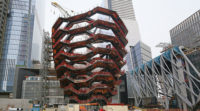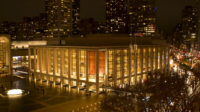Laverstoke, U.K.
Thomas Heatherwick capped his adaptation of a historic paper mill in southern England into a production facility and visitor center for Bombay Sapphire gin with a grandiose gesture. Among a cluster of industrial structures dating back to the 18th century, an asymmetrical pair of fluted glass domes erupts from the brick walls of what is now the main distillery hall. These surrealist greenhouses showcase the plants that give the gin its trademark ten botanical notes.
The large-scale bell jars are the centerpiece of a five-acre mill complex that the firm renovated for Bombay Sapphire, and the bulbous forms do double duty for the gin maker. They provide visitors with a spectacle of contemporary design acrobatics, but they also lend the brand a sense of heritage by referencing historic architecture. “We wanted to take that Victorian history of glass construction forward into the 21st-century,” says project architect Eliot Postma, citing the Palm Houses at Kew Gardens and the original Crystal Palace by Joseph Paxton as sources of inspiration.
The unusual shape of these massive garden cloches was also guided to a degree by function. Their framework conceals curving pipes that seem to billow out of the distillery hall. More than a gesture, the pipes syphon heat produced by the gin-making process and circulate it through the greenhouses.
“There was no glass house in the brief, no requirement to showcase the botanicals,” Postma says, explaining how the firm devised the greenhouses to combat the dryness of the usual visitor center. “Our driver was to bring the real plants to the site and to allow the public to see the real process. It’s a juxtaposition of this serious place of production with this sense of amazement.”












Post a comment to this article
Report Abusive Comment